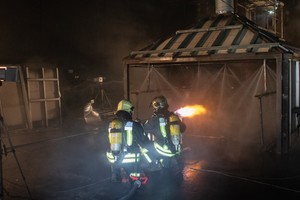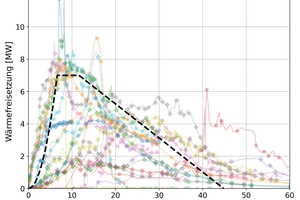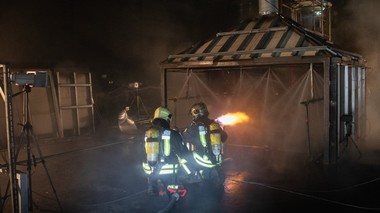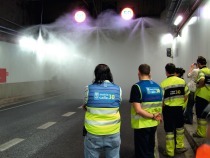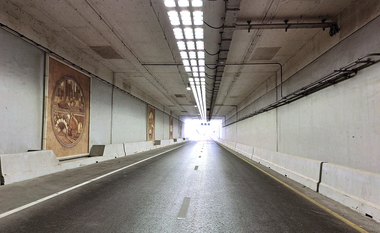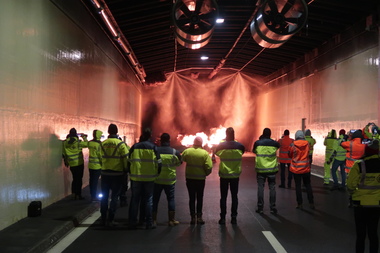Investigation of Fires with Electric Vehicles in Underground Traffic Areas
The electrification of passenger cars is progressing nationally and internationally. Some of the growth rates exceed the forecasts, and major car manufacturers have already announced fixed dates for the complete phase-out of passenger cars with combustion engines. At the same time, initial experience has been gained with accidents and fires involving electric vehicles. However, a sufficient database from actual accidents on the fire behaviour of passenger cars with lithium-ion batteries is not yet available. This situation gave rise to the SUVEREN research project in 2017 with the aim of scientifically investigating the effects of vehicles with new energy carriers (NEC) on safety in underground traffic areas.
In the few cases of fire that have already occurred, intense fires were sometimes observed that were difficult for emergency services to extinguish completely. Initial experiences with such fires (and statements by the Tesla company, for example, that at least 11 000 litres of extinguishing water would be required for a fire in their cars) have led to questions and uncertainty. A well-founded assessment of the consequences for fire protection requirements in underground transport facilities has so far hardly been possible, if at all.
Initial Findings and Recommendations from the SUVEREN Research Project
The SUVEREN project (Safety of Urban Underground Structures due to the Use of New Energy Carriers) also dealt with fires involving hydrogen and gas-powered vehicles, but the focus was on cars with lithium-ion batteries due to the urgency of the open questions. A consortium consisting of the German Federal Institute for Materials Research and Testing (BAM), STUVA and the company Fogtec carried out the investigations. The German Federal Ministry of Education and Research provided significant funding for the project.
The development of practical recommendations for dealing with NECs in underground transportation facilities was one of the most important goals of SUVEREN.In the following, the work content processed by Fogtec and relevant results are reported.
Fire Simulations under Realistic Conditions
In the initial phase, the consortium focused on the very insufficient data available on the fire behaviour of lithium-ion batteries. In order to obtain reliable and detailed knowledge, fire tests were carried out under the most realistic conditions possible and on a 1:1 scale. IFAB GmbH, Berlin, was responsible for planning, preparing and conducting the fire tests.
In the course of the project, several test series were carried out with different objectives. The battery packs and modules that were used were each fully charged and came from series-production vehicles of a German manufacturer. In the first series of tests, the aim was to gain basic knowledge about the fire behaviour of lithium-ion batteries, from ignition to the cooling process. To determine the temperature distribution and heat release, a new test stand was designed and constructed (Fig. 1). Various gas sensors, a large number of thermocouples, devices for measuring the radiant heat and the mass loss rate as well as thermal imaging cameras were positioned in it. The flue gas composition was also investigated with a highly sensitive Fourier transform infrared spectrometer (FTIR), which analyses the flue gases down to the low single-digit ppm range. In addition, the response behaviour of all major types of commercially available fire and smoke detectors was investigated.
Effectiveness of Different Firefighting Technologies
In a second series of tests, different firefighting technologies, such as sprinklers, water mist, foam, F 500, aerosol, nitrogen, carbon dioxide and Novec 1230, were tested for their extinguishing effect. This was the first time that different firefighting systems were compared scientifically under identical and reproducible conditions.
The batteries used were ignited by mechanical impact or overcharging and in some cases showed very fast and strong reactions with explosions, up to 1.5 m long flames and intense heat release. Temperatures of up to 1000 °C were measured on the surfaces of the batteries. The analysis of the fumes did not reveal the expected considerable amounts of hydrofluoric acid (HF), but up to ten other highly toxic and corrosive substances appeared in critical quantities. It was observed that battery fires can differ significantly depending on cell composition and cell type. The type of ignition also plays a major role here.
The tests on fire detection and extinguishing showed that, despite the special fire behaviour of lithium-ion batteries, successful intervention is possible in principle both manually and by means of stationary fire-fighting systems. A summary of the results is planned to be published together with a guide for fire protection in underground transportation facilities in the first half of 2021.
Electric Vehicle Fires in Underground Garages
As part of a third series of tests, experiments were conducted in the second half of 2020 to investigate electric vehicle fires in underground car parks. For this purpose, the spatial geometry of a part of an underground car park was simulated. A representative model of a passenger car was positioned in the garage. The primary objective of the study was to investigate the effects of an electric car fire on the structure of the building and the escape conditions. At the same time, the tests were used to develop and test a system for the earliest detection of battery fires and their suppression. The fire tests were accompanied by the technical inspection agencies TÜV Süd and DEKRA.
The dummy car used corresponded to a fire power of approx. 7 MW, based on the design fire for a car, which was derived and calculated during the course of the project from the analysis of documented car fires (Fig. 2). Thus, according to current knowledge, a higher fire power can be assumed than according to previous assumptions and guidelines. However, this applies not only to electric cars but also to cars with combustion engines. The significantly increased potential fire performance compared to the past is in fact due to the increasing size of modern passenger cars and the increased use of plastics in the bodywork as well. It is therefore to be expected that various recommendations from the past will require updating.
In the SUVEREN project, a fire protection concept for car fires was therefore developed especially for multi-storey and underground car parks. The findings also confirm the assumption that a tunnel built according to the current state of technology (e.g. RABT, etc.) will withstand a fire of one or more passenger cars (regardless of whether they are conventionally or battery driven) sufficiently and well and that the measures for ventilation and escape are sufficient.
Large Vehicles with NECs
Other considerations may become necessary with regard to large vehicles such as trucks and buses that are powered by batteries or also hydrogen. Whether and to what extent the effects due to the composition of flue gases from fires with lithium-ion batteries necessitate revisions to the previous fire protection requirements is part of the analysis of the data obtained in the trials that is currently underway. In any case, the increasing equipment of buses and trucks with new energy sources should be closely observed. Further investigations with additional and larger fire tests are necessary in this area in order to reliably answer questions from fire brigades and operators in this regard.
Further information on the research project can be found on the SUVEREN website.

